It is probably not an exaggeration to say that among the key categories of ESG, S or Social receives the least attention.
E or Environmental hogs the limelight, especially given the intense debate over climate change and its noticeable impact on our lives and livelihoods. G or Governance, on the other hand, has its claims as the predecessor of the whole ESG movement as corporate governance has always been a major theme for investors.
In this week’s post, we will look at a few data vendors’ methodology documents to see how they measure the Social aspect of ESG.
Let’s begin!
Definitions
Under MSCI, we see that the data provider classifies the following themes under the Social pillar: Human Capital, Product Liability, Stakeholder Opposition and Social Opportunities.
For another data provider Sustainalytics, ESG risks are not nicely bucketed into each category of E, S and G. Instead, it uses a Material ESG issues framework below, and each sub-industry has issues that are more applicable to them:
Among the key issues above, the ones that I find to be most related to the Social aspect are Access to Basic Services, Community Relations, Data Privacy and Cybersecurity, E&S Impact of Products and Services, Human Rights, Human Rights - Supply Chain, Human Capital, Occupational Health and Safety, as well as Product Governance.
Before we jump into another data provider, it’s not hard to see that there are some overlap with the key issues from MSCI. These mostly relate to human capital, product safety and access to services. What is quite surprising is that data and cybersecurity is also a key theme of the Social aspect of ESG, but thinking deeper, data and cybersecurity are somewhat related to product safety and user experience.
Let’s look at one more data provider, Refinitiv, which takes a similar approach to MSCI by grouping key issues into each of the E, S and G bucket.
Again, the key themes under Social seem to be Workforce, Human Rights, Community and Product Responsibility. Refinitiv also provides a breakdown of the number of metrics for each category (the numbers in the doughnut chart above). As you can imagine, the Workforce category is probably the easiest to quantify, hence it has the highest number of metrics. Human Rights, on the other hand, may be a bit more subjective and harder to measure.
Measuring S Scores
Among the data providers, MSCI has the most transparent and accessible methodology documents, so we will use that as a baseline.
Recall that under MSCI, the four key themes are Human Capital, Product Liability, Stakeholder Opposition and Social Opportunities. There are several key issues under these themes, but we will not jump into all of them here and will only highlight a couple of the more pertinent and interesting ones.
Let’s put on our ESG rating agency hat for a second: how would you gauge if a company is doing well in Human Capital?
At the very least, the company has to pay a decent wage, workers have a healthy work environment and employees are not discriminated against.
Let’s look at how MSCI measures this by diving into the key issue known as Labor Management, under Human Capital:
The Labor Management management score1, in turn, is the average of these three scores:
Under Strategy Score, a company is measured on the following:
Employee equity programs
Workforce eligible for non-pay benefits (including pensions and 401k)
Workforce eligible for variable pay
Under Programs & Initiatives Score, the following metrics apply:
Employee satisfaction survey frequency
Restructuring policies and programs
Scope of skills and knowledge development training
Support for degree programs or certifications for employees
Lastly, under Performance Score, these are the relevant metrics:
Employee turnover
Employee productivity
Strikes
External recognition
This seems like a fair representation of a company’s management of its workforce. Happier employees should lead to lower turnover, higher productivity and fewer strikes. It seems like our earlier attempt was not too far off the mark!
The next key issue that we would look at is on Community Relations, given that both Refinitiv and Sustainalytics also have this as one of their categories under S.
The Community Relations management score uses the formula below:
Let’s look at each of the score used in the formula.
The Community Impact and Disturbance Score measures the following:
Commitment to refrain from operating in protected areas, such as World Heritage sites
Company conducts community impact assessment prior to settling in new areas
Indigenous peoples policy
Local community engagement approach
The Conflict and Human Rights Score, meanwhile, looks at:
Company monitors the effectiveness of its human rights policy
Employee training on human rights protection
Ethical conduct policy covers contract security providers
Human rights policy: Has the company adopted a formal human rights policy?
Violence and conflict policy: Does the company have a formal policy related to violence and conflict?
The Distribution of Benefits score relates to how the company supports the local community by looking at its:
Local procurement policy
Programs to support local communities
As you can see, the scores above probably do not apply to many companies out there, unless their business involves working with the local community. Furthermore, these scores may also have a positive bias on larger companies, as these firms tend to have the resources and manpower to formally document their human rights and violence policies. Instead of really measuring a company’s real ability in managing community relations, sometimes this exercise just ends up rewarding companies that report well.
We should also point out that MSCI would also subtract scores from the overall management score for this key issue if the company is involved in controversies surrounding human rights, community impact and indigenous peoples. Therefore, it is important to avoid controversies to score well in this aspect.
Summary
Compared to E and G, I always find the Social component of ESG to be the hardest to understand and measure. Across the three major ESG data providers (MSCI, Sustainalytics and Refinitiv), there appears to be significant overlap in themes for this issue, particularly regarding a company's workforce, community relations, human rights, and product safety.
While we didn't delve deeply into product safety in this post, it represents a significant risk for any company beyond ESG considerations. Any recalls or safety-related breaches would undoubtedly harm the company's finances and reputation. Similarly, a company's workforce is crucial in its own right, not just for ESG reasons. A company with poor human resources management may struggle to compete or even survive in the long term.
My point is that most well-run companies already excel in these aspects (maintaining low employee turnover and ensuring product safety) without needing a dedicated ESG department. These practices are fundamental to good business operations. For any successful company, these aspects are the non-negotiable cornerstones of operation.
However, when it comes to establishing official policies on human rights, workforce diversity, and implementing outreach programs to support local communities, an ESG specialist may be required. Not all companies need or have the resources to pursue these initiatives.
So, the next time you come across a company with a poor S score, it is important to distinguish what it is being marked down for: is it due to poor labor management or the absence of a formal community outreach program? The former is essential for a company’s survival, while the latter, though valuable, is more of a nice-to-have feature.
MSCI measures both Exposure and Management scores for each key issue. The former evaluates a company’s exposures to the particular risks and the latter evaluates how a company manages said risk. For the sake of our discussion, we will only include the breakdown of the management score and skip the exposure score.





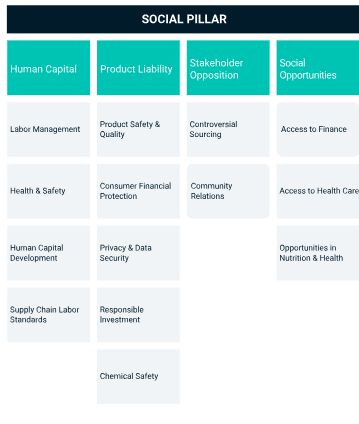
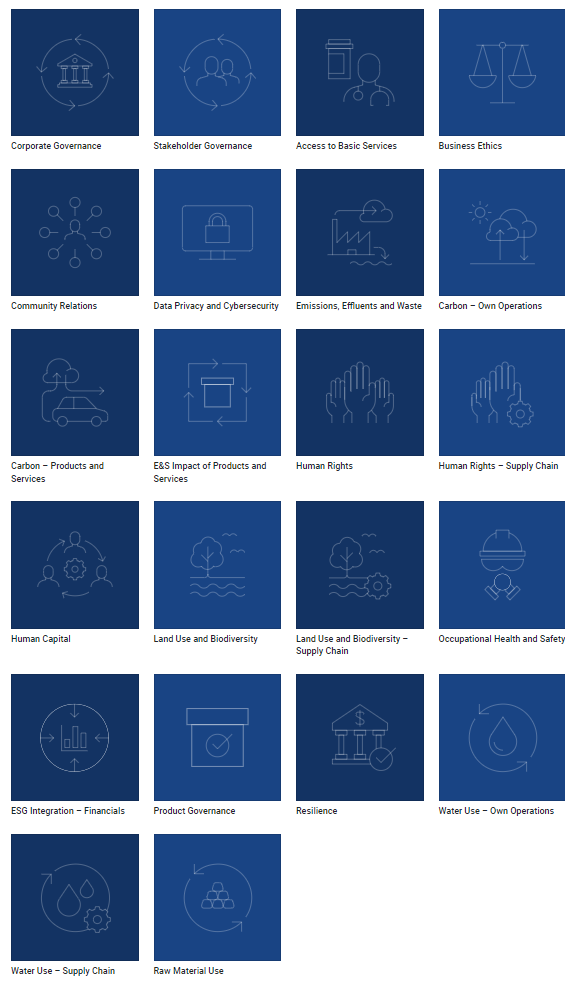
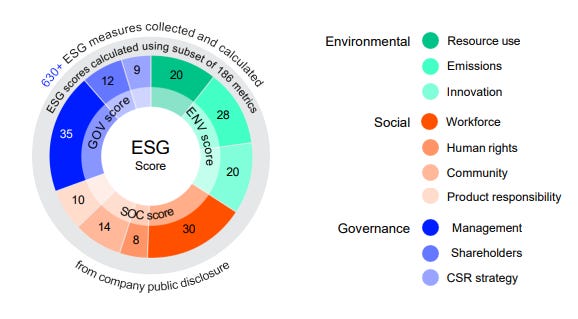
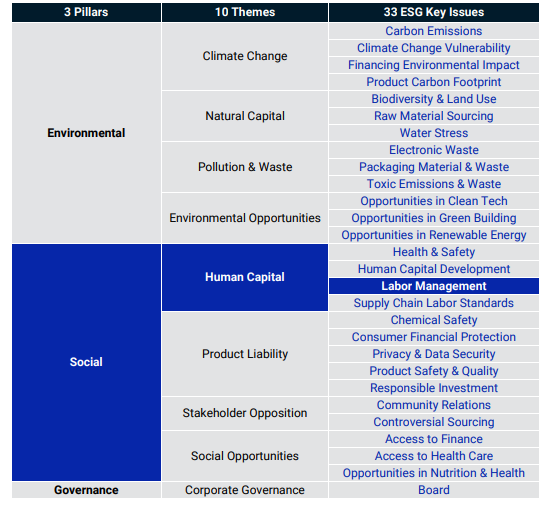
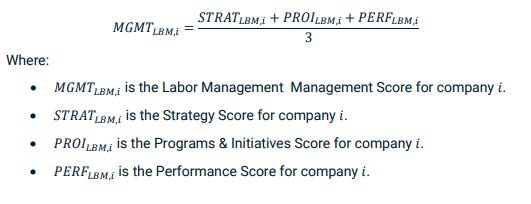

Good summary, thanks for sharing. My two cents on Social in general. I find the term/label to some extent misleading as it has strong internal focus on workforce/employees, much bigger than on community and wider society. The other thing is having a policy as a measure. It is important as a starting point but again it is an internal effort, in some cases it's just adaptation of some template. What really matters is policy implementation and ultimately its effects beyond. I know this is hard to track in standardised manner, but worth investing some thinking into it.